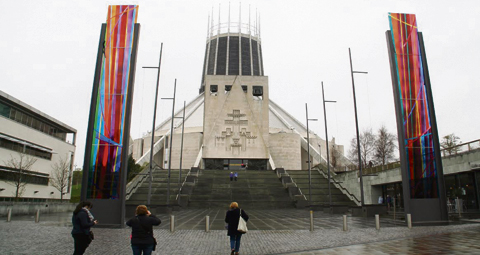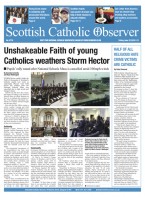July 17 | ![]() 0 COMMENTS
0 COMMENTS ![]() print
print

A shrine and a tale of two cathedrals
HUGH DOUGHERTY takes us on a whistlestop tour of the sights in Liverpool that would be of interest to Catholic tourists
The middle of April found us on a Liverpool short break, while I did a magazine story on the centenary of the sinking of the Lusitania on May 7, 1915 by a German U-boat off the Old Head of Kinsale, en route from New York to her Merseyside. I was previewing an exhibition in
Liverpool Maritime Museum marking the tragedy, in which 1191 out of 1962 passengers and crew died, many coming from Liverpool itself.
We also did the ‘pilgrimages’ that people our age do, paying homage at the Beatles shrines and museums, all specially relevant, as at 64, we both remember the Fab Four’s debut clearly. My wife recognised a pair of Beatles nylons on display, and recalled that Sister Aquinas—headteacher at Garnethill Convent School—had lambasted three bold girls, who, wearing such attire, had ‘dogged’ school to see the Beatles when they played in Glasgow. Shocking!
But Liverpool also took us on a more spiritual pilgrimage towards its two cathedrals, one Anglican and the other Catholic, standing, appropriately enough, at either end of the city’s Hope Street. For, Liverpool, is very like Glasgow, with a vast influx of Irish exile arriving in the years following the Great Famine, and the town itself grew as a Mersey port and manufacturing centre, just as Glasgow did on the Clyde.
Sectarian divisions soon arose, but, with the restoration of the English hierarchy in 1850, it was clear that the Irish were there to stay. Today, Liverpool Archdiocese, which includes the city, large parts of Lancashire, and towns such as Wigan and Southport, estimates its Catholic population at 574,000, but with just 10 per cent, or 54,772 souls attending Mass regularly.
There are the same challenges that we face in Glasgow, with ageing church buildings, parishes in the wrong place in a redeveloped city, a shortage of clergy, and dropping income, yet, when we visited the Cathedral Church of Christ the King (above), it was clear that Catholicism still holds a valued place in Liverpool.
The 1967-built cathedral dominates, and can be seen from viewpoints across the city, including the Mersey Ferries, made famous by Gerry and the Pacemakers. The church’s unique architecture quickly earned it the Scouse moniker of ‘Paddy’s Wigwam’ and the circular cathedral is regarded with special affection throughout Liverpool.
Impressive it is, with the high altar at the heart of its circular body, its massive organ, and the stained glass at the very top of the ‘wigwam,’ scattering the colours of the spectrum into side altars and chapels.
We dropped into lunchtime Mass, celebrated in the crypt, and so opening the door to a longer and complex tale of how the cathedral came to be on what was the city’s workhouse site. For the crypt should have supported a vast cathedral, designed by the famous architect Edwin Lutyens, which would have soared to the heavens, being even higher than the massive Anglican Cathedral at the other end of Hope Street.
This was a statement about the Catholics having arrived, and, when Archbishop Richard Downey laid the foundation stone of the new building in 1933—an event attended by thousands of Catholics, there were sectarian riots in protest—showing that the old forces of division were still alive and well.
The sheer scale of the proposed cathedral can be appreciated today thanks to a giant, architect’s model on show in the Museum of Liverpool. Round it, are information panels telling its full story, including mention of a fundraising drive which included the church’s building fund taking a share of the profits from specially rolled ‘Cathedral’ brand cigarettes!
You couldn’t imagine the Church promoting such holy smoke today, and, even with this and professional posters; no building work took place above the crypt thanks to the 1930s depression. Post-war, the estimated cost of the cathedral had soared to £27m, and, despite a false start on a scaled-down version in 1953, it took the new Archbishop, John Heenan, later, Cardinal Heenan, to scrap the old plans entirely, and sensibly, promote today’s edifice.
Liverpool has plenty of Catholic churches, but it was still both surprising and gratifying to find the Blessed Sacrament Shrine, bang in the middle of the city, beside busy Queen Street bus station. The shrine’s lunchtime Mass is popular, and, when we dropped in for a quick prayer, there were several people, of all ages, also saying a quick one, and benefitting from the calm of the Real Presence in the heart of the bustling city.
We didn’t get time to view Liverpool’s two Irish Great Hunger memorials—one at St Luke’s Catholic Church, and the other at the gates of Clarence Dock. There, a plaque recalls the one million plus Irish exiles who passed through the port post-1848, many settling in Merseyside and others sailing to the New World. But we did see the ‘Arandora Star’ memorial, recalling that the ship sailed from Liverpool, its sinking also commemorated at St Andrew’s Cathedral garden memorial in Glasgow.
So, that’s Liverpool, as much a pilgrimage destination as a magical mystery tour, and worth a visit, even though the Catholic cathedral never did manage to top the Anglican version by reaching even closer to Heaven!











